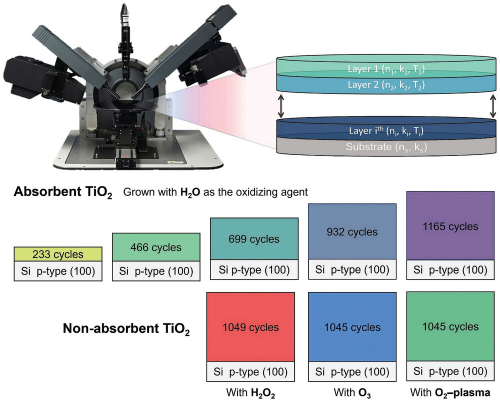Semilab publishes paper on “Optical Properties of TiO2 Grown by Atomic Layer Deposition Using Various Oxidizing Agents: The Ellipsometry Analysis of Absorption Properties”
07.17.2024

Semilab publishes study on analyzing the optical properties of TiO2 films grown via atomic layer deposition (ALD) using Tetrakis(dimethylamino)titanium with oxidizing agents such as H2O, H2O2, O3, and O2-plasma. TiO2-H2O exhibited Ti3+ states and oxygen vacancies characteristic of black TiO2, enhancing visible-NIR light absorption. This effect increased with more ALD cycles due to the surface memory effect, leading to a decreased growth rate. In contrast, films grown with H2O2, O3, and O2-plasma are more stoichiometric, has fewer defects, and show no visible-NIR absorption due to the absence of Ti3+. TiO2 films deposited with H2O also show increased surface roughness and hydrophobicity, while films grown with other oxidizing agents exhibited higher roughness but decreased hydrophobicity. Ellipsometry and UV–vis spectroscopy confirmed that TiO2 films grown with H2O has an increased refractive index and extinction coefficient in the visible range, along with a bandgap widening due to the Moss-Burstein effect. Conversely, films grown with other oxidizing agents showed a decreased bandgap with increasing thickness and an increased refractive index but a zero extinction coefficient below the bandgap. Mid-IR ellipsometry measurements revealed the dielectric response, highlighting the critical role of the oxidizing agent in tailoring the properties of TiO2 films for energy and environmental applications.
Read the full study HERE.





